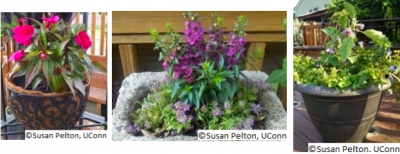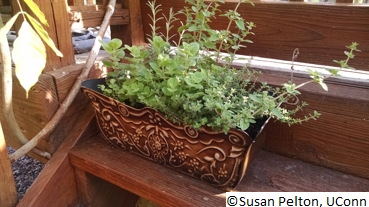Since earliest times, people have needed and enjoyed plants. Where the climate was unfavorable, or the soil or water was scarce, containers made it possible to satisfy that desire. Container gardening is ideal when space is limited. It is a technique which permits plant materials to be moved around easily, to be changed or renewed as desired and to be enjoyed at close range. Plantings can be as simple or as elaborate as space, inclination, taste and funds permit.

Container Selection
Having decided where to place the plants, consider the selection of containers. Many kinds are available: ordinary clay pots, wooden boxes, barrels, tubs, and metal and plastic. All should have drainage holes in the bottom. Old kettles, jugs and crocks make interesting containers, and boxes built in various sizes can be stacked in intriguing combinations. It is a good idea to treat wooden objects with a preservative such as copper naphthenate.
Choosing the basic container is important. If using unglazed clay pots, be aware that they dry out quickly unless double potted (one pot placed within a larger one with the space between being packed with damp sphagnum or peat moss.) The roots of clay-potted plant, if not double potted, will tend to grow along the side of the pot and be more affected by changes and extremes of temperature and soil moisture. Plastic pots keep the contents moist much longer, and the roots tend to grow throughout the soil ball rather than at the side of the pot. left to right, coco coir fiberliner, hypertufa, and plastic planters.

Plant Selection
The duration and intensity of sunlight is important when selecting plants. Keep in mind compass exposure (southern has more light than northern) and nearby structures (buildings, trees, overhangs).
Many vegetables, herbs and annuals can be grown in full sun or very bright light. For shady locations, leafy vegetables and shade-tolerant plants such as impatiens, tuberous begonias, fuchsias and ferns will do nicely.
In the early spring, forget-me-nots or pansies can be placed into the container, and when their blooming period is over, summer--blooming annuals can take their place. Sweet-scented plants such as nicotiana, santolina, lavender, and thyme will delight the senses.
Vines for shade and screening may be incorporated directly into a window box or trellis-type planter. Selections include morning glory, gourds, cucumbers, squash and scarlet runner (pole) beans for the annual screen. For permanent living screens choose among such plants as clematis, Virginia creeper, Boston ivy, trumpet vine and English ivy.
If the interest is in herbs and the location is sunny, choose chives, mints, oregano, parsley, rosemary, sage, summer savory, sweet marjoram, tarragon and thymes. All are fragrant as well as delightful to the palate. Ornamental kale, lettuce, tomatoes, eggplant, bush squash, peppers and Swiss chard are vegetables which adapt well to container gardening and provide ornamental value at the same time.
Cultural Requirements

Because it is essential to water and fertilize container-grown plants regularly, the potting mixture should be light and friable. A good general soil mix can be made with one part loam or topsoil, one part conditioner (peat moss, leafmold or compost) and one part soil lightener (vermiculite* or perlite). To each six-inch pot of mixture, add one tablespoonful of limestone and one teaspoonful of 5-10-10 fertilizer. *Vermiculite may contain 2-3% asbestos fibers and as such, care should be taken when using it. Asbestos presents the greatest problem when it is inhaled so work in a well-ventilated area, wear a dust mask when pouring it, and wet it as soon as possible to further control the dust as it is mixed with other materials.
During the growing season, especially if the plants are large and the weather is sunny and/or windy, the plants may need watering one or more times per day. This may lead to a lack of plant nutrients in the limited soil volume in the container. It is possible to avoid the problem by using a water-soluble fertilizer when watering. A very weak solution (one teaspoonful per gallon of water) may be used at each watering, or a stronger solution (one tablespoonful per gallon of water) can be used every seventh to tenth watering.
Maintain adequate moisture levels in the soil. Any wilting of the plant will reduce growth and delay or prevent flowering. Check the plants at least twice a day, and water when needed. Plants such as fuchsias and other hanging basket materials may have to be watered more than twice a day in hot or windy weather.
All plants grown in containers will benefit from a mulch such as compost, peat moss, or sphagnum moss. A mulch will help conserve moisture, keep the soil cool and prevent splashing of earth on foliage when plants are watered or during rainstorms. Do not place rocks or pebbles in the base of containers as an assistance to drainage. Water will not drain from the soil layer into the rock layer unless the soil is entirely saturated. Soil that is partially saturated will cause water to collect in the soil just above the rocks where it will not drain and will just remain at the root level where it will waterlog them.
By its exposure, the container garden site will dictate what will grow successfully and how to arrange the plants. Since strong winds and sun may present problems, here are some suggestions on how to correct the situation:
- Construct baffles or screens of opaque plastic or fiberglass to reduce light intensity.
- Construct a screen, either of louvers or lattice, or a trellis on which to grow appropriate vines to reduce light and wind.
For pesticide information or other questions please call toll free: 877-486-6271.
Revised 2017 by the UConn Home and Garden Education Center